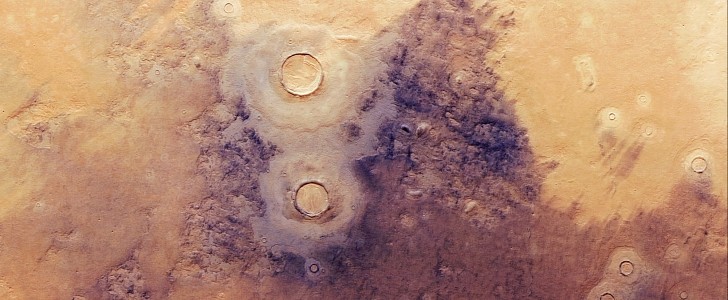This alien landscape that you're seeing was recently spotted by the European Space Agency (ESA) Mars Express spacecraft, which has been busy mapping and analyzing Mars' surface since 2003. This intriguing ice-rich region covered by impact craters is just a slice of Utopia Planitia, the largest impact basin on the Red Planet and in the Solar System.
Using its High-Resolution Stereo Camera (HRSC), the spacecraft has captured over the years plenty of various features on the surface of Mars. And the latest image taken by the Mars Express is nothing short of impressive. You're looking at a small portion of Utopia Planitia that is covered by impact craters.
Two are more noticeable since they're right in the center of the image (click the main picture to enlarge) and are relatively more extensive than the rest. In this photo, the second-largest crater actually shows what is known as brain terrain.
As the name suggests, this type of terrain resembles the intricate patterns and ridges found on the surface of the human brain. It's usually found in ice-rich regions, and it's a result of the ground ice melting or turning to gas. This process is what gives the surface its brain-like pattern.
The brain terrain is not only found around the second-largest crater but also next to it as well. To the right, there's a region that appears darker. At low temperatures, the ice-rich ground cracked and contracted, forming various patterns that collected the Martian dust that was blown across the surface over time.
The image also shows mantled deposits, which are thick layers of ice-rich material thought to have been formed as snow around 10 million years ago. These mantled deposits seem to encircle the two impact craters as well. The sediments that have piled up within the craters, as well as on their edges, have a similar layered look. Overall, it's an interesting image that shows just how diverse the Martian landscape can be.
Two are more noticeable since they're right in the center of the image (click the main picture to enlarge) and are relatively more extensive than the rest. In this photo, the second-largest crater actually shows what is known as brain terrain.
As the name suggests, this type of terrain resembles the intricate patterns and ridges found on the surface of the human brain. It's usually found in ice-rich regions, and it's a result of the ground ice melting or turning to gas. This process is what gives the surface its brain-like pattern.
The brain terrain is not only found around the second-largest crater but also next to it as well. To the right, there's a region that appears darker. At low temperatures, the ice-rich ground cracked and contracted, forming various patterns that collected the Martian dust that was blown across the surface over time.
The image also shows mantled deposits, which are thick layers of ice-rich material thought to have been formed as snow around 10 million years ago. These mantled deposits seem to encircle the two impact craters as well. The sediments that have piled up within the craters, as well as on their edges, have a similar layered look. Overall, it's an interesting image that shows just how diverse the Martian landscape can be.






